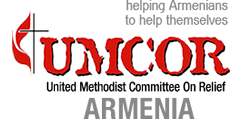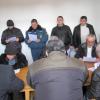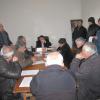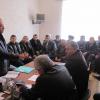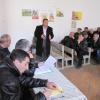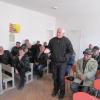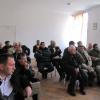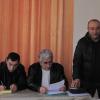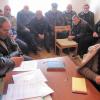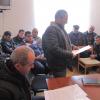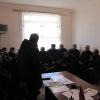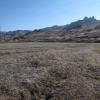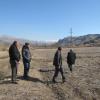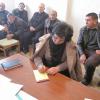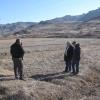CIDAP
UMCOR has implemented successful agricultural development programs in Armenia since 1997.
Starting from December 1999, UMCOR has supported the establishment of seven farmer associations through the Community Associations Program. This program evolved into UMCOR’s Farmers Organizations Support Program in Armenia (FOSPA) . Through FOSPA, UMCOR assisted 19 rural communities in Ararat, Armavir and Vayots Dzor Marzes with the establishment and development of agricultural cooperatives. During the initial phase, these farmer organizations (FO) received technical assistance from UMCOR on forming groups, conducting a community needs assessment, establishing and formally registering cooperatives, developing business plans and applying for loans. FOs also received UMCOR financial support in the form of grants (administrative, business support and agricultural equipment) and loans (interest-free and interest bearing). The cooperatives received loans for procuring agricultural inputs in bulk and providing agro-machinery services, allowing member-farmers to reduce their production costs and increase their incomes. FOs received multiple trainings and consultancies as well.
With funds from a variety of donors, UMCOR worked with rural communities countrywide. From 2004 to 2006, with funding from the U.S. Department of Agriculture, UMCOR established three demonstration farms in one of Armenia’s poor marzes, Gegharkunik, and provided technical assistance and training to over 12,000 local farmers.
Strengthening the Role of Women in Agricultural Cooperatives (SRWAC) Project that UMCOR started in November 2007 was built on UMCOR Armenia’s experiences in assisting farming communities to establish and develop agricultural associations through FOSPA. Under the program, UMCOR extended assistance to support the further development and strengthening of existing FOs by identifying, training and empowering women involved in agriculture. The primary purpose of each established Women Committee (WC) was to strengthen the role of women in cooperatives and address community issues. As a result of the SRWAC project Women’s Committees were established at 10 communities. UMCOR also organized and executed trainings in areas such as how to conduct a needs assessment, proposal writing, democracy in rural communities, and success stories of other women working through cooperatives to create change locally. To highlight and stimulate the role of women, and to help cooperatives achieve social goals in the community, small grants were awarded to Women’s Committees to support their activities under the project. These included social, health and education needs and the recipients of assistance were extremely vulnerable families, elderly and vulnerable children.
Since 2009 UMCOR has been implementing Sustainable Cooperative Extension and Agricultural Development (SCEAD) program funded by USDA “Food for Progress” Program. The project supported member farmers and small-scale agricultural entrepreneurs to improve their livelihoods through development of their production management, pre-processing and marketing capacities and through technical assistance, training and demonstration projects. Within the scope of the project financial, marketing, technical and advisory assistance have been provided to 14 newly established consumer cooperatives, as well as to 10 existing agricultural cooperatives established by UMCOR in 2003-2006 within the scope of FOSPA. The program was implemented in Ararat, Armavir and Vayots Dzor regions. Through the SCEAD project, UMCOR collaborated with CARD, Agricultural Support Regional Centers of the target regions and other stakeholders.
The main outcomes of SCEAD program are -- 21 Cooperatives received agricultural equipment, such as tractors (Belarus 82-1, Belarus 921 or New Holland type) and other accessories; 3 new milk and dairy cooperatives received milk collection spots; 72 agriculture extension films completed and broadcasted in Ararat, Armavir and Vayots Dzor marzes; 5,000 handbooks published and distributed to farmers; 28 demonstration projects implemented in high value agriculture, post-harvest pre-processing, and marketing; 3,600 individual rural community members adopted improved agricultural practices.
The knowledge and skills gained by the beneficiaries through trainings and the results of the program witnessed through demonstrations will motivate the adoption of improved farming techniques and new technologies. Through the utilization of the agro machinery equipment/accessories and increase in post-harvest pre-processing and marketing capacities, farmers are now able to improve yield, enhance product quality, and increase sales of their products, which will result in improved quality of life for the farmers and their families.
Farmers from 14 new and 10 existing cooperatives received technical assistance trainings in cooperative development, management, conducting needs assessment, business plan development, financial management, accounting, taxation, plant protection, farm management, environment and land protection, water resource management, organic agriculture and livestock husbandry and veterinary. Short term impacts include achieving integration of small farmers into producer organizations and empowering individual farmers through a commonly owned enterprise. This leads to the increase of bargaining power for the cooperatives. Individual farmers adopt the use of modern fertilizers and modern agro-technologies through which they gain improved production quality. Moreover, with the application of improved plant protection knowledge and skills, farmers will increase production yields and, therefore, household incomes.
Community Integration & Development Agricultural Project
Target Areas: Vernashen, Gladzor and Agarakadzor communities of Vayots Dzor Marz
Project Implementation Period: January 1,2014 - December 31, 2014
Donor: UMCOR
Project Goals:
UMCOR's program is designed to respond to both dynamics by enhancing agricultural extension and establishing cooperatives in communities that have been or will be neglected by other assistance programs and by building a more advanced, market-oriented capacity in communities where cooperatives and agricultural organization have already proven to be effective. UMCOR will establish two agricultural cooperatives: one cooperative in Vernashen and Gladzor communities, and one greenhouse cooperative in Agarakadzor community. The communities of Vernashen and Gladzor are geographically near to each other and their agricultural lands are on the same territory. Thus, the joined use of agro-machinery will be reasonable and effective by both communities’ member-farmers. The cooperative management will be presented by farmers from both communities. In Agarakadzor, a greenhouse will be constructed. The established cooperative will manage it.
The purpose of the mixed model to be used in CIDAP is so that agro-machinery services will be available for the Agarakadzor cooperative with the same costs as Vernashen and Gladzor's cooperative and so the Agarakadzor greenhouse products will be available for Vernashen and Gladzor cooperative with the same cost as for Agarakadzor cooperative members.
Project Objectives:
- Offer innovative agricultural extension to encourage adoption of improved farming techniques and agricultural technologies within rural communities
- Create new agricultural cooperatives to maximize economies of scale in agricultural production, and provide technical assistance and training to improve organization and farm management and the agricultural methodologies Provide agricultural machinery and equipment to create a sustainable asset base for cooperative growth
- Provide technical assistance and training to develop marketing capacities and opportunities for cooperatives.
- Establish greenhouse to encourage adoption of innovative agro-techniques and provide seedlings and fresh vegetables to community members
- Create rural communities integration via agricultural development project by common technical assistance, input supplies distribution, marketing and joint use of agro-machinery in two neighboring villages.
